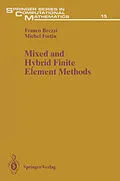Research on non-standard finite element methods is evolving rapidly and in this text Brezzi and Fortin give a general framework in which the development is taking place. The presentation is built around a few classic examples: Dirichlet's problem, Stokes problem, Linear elasticity. The authors provide with this publication an analysis of the methods in order to understand their properties as thoroughly as possible.
Inhalt
I: Variational Formulations and Finite Element Methods.- Classical Methods.- Model Problems and Elementary Properties of Some Functional Spaces.- Duality Methods.- 3.1. Generalities.- 3.2. Examples for symmetric problems.- 3.3. Duality methods for nonsymmetric bilinear forms.- Domain Decomposition Methods, Hybrid Methods.- Augmented Variational Formulations.- Transposition Methods.- Bibliographical remarks.- II: Approximation of Saddle Point Problems.- Existence and Uniqueness of Solutions.- 1.1. Quadratic problems under linear constraints.- 1.2. Extensions of existence and uniqueness results.- Approximation of the Problem.- 2.1. Basic results.- 2.2. Error estimates for the basic problem.- 2.3. The inf-sup condition: criteria.- 2.4. Extensions of error estimates.- 2.5. Various generalizations of error estimates.- 2.6. Perturbations of the problem, nonconforming methods.- 2.7. Dual error estimates.- Numerical Properties of the Discrete Problem.- 3.1. The matrix form of the discrete problem.- 3.2. Eigenvalue problem associated with the inf-sup condition.- 3.3. Is the inf-sup condition so important?.- Solution by Penalty Methods, Convergence of Regularized Problems.- Iterative Solution Methods. Uzawa's Algorithm.- 5.1. Standard Uzawa's algorithm.- 5.2. Augmented Lagrangian algorithm.- Concluding Remarks.- III: Function Spaces and Finite Element Approximations.- Properties of the spaces Hs(?) and H(div; ?).- 1.1. Basic results.- 1.2. Properties relative to a partition of ?.- 1.3. Properties relative to a change of variables.- Finite Element Approximations of H1(?) and H2(?).- 2.1. Conforming methods.- 2.2. Nonconforming methods.- 2.3. Nonpolynomial approximations: Spaces Lks(Eh).- 2.4. Scaling arguments.- Approximations of H (div; ?).- 3.1. Simplicial approximations of H (div; K).- 3.2. Rectangular approximations of H (div; K).- 3.3. Interpolation operator and error estimates.- 3.4. Approximation spaces for H (div; ?).- Concluding Remarks.- IV: Various Examples.- Nonstandard Methods for Dirichlet's Problem.- 1.1. Description of the problem.- 1.2. Mixed finite element methods for Dirichlet's problem.- 1.3. Primal hybrid methods.- 1.4. Dual hybrid methods.- Stokes Problem.- Elasticity Problems.- A Mixed Fourth-Order Problem.- 4.1. The ?-? biharmonic problem.- Dual Hybrid Methods for Plate Bending Problems.- V: Complements on Mixed Methods for Elliptic Problems.- Numerical Solutions.- 1.1. Preliminaries.- 1.2. Interelement multipliers.- A Brief Analysis of the Computational Effort.- Error Analysis for the Multiplier.- Error Estimates in Other Norms.- Application to an Equation Arising from Semiconductor Theory.- How Things Can Go Wrong.- Augmented Formulations.- VI: Incompressible Materials and Flow Problems.- Introduction.- The Stokes Problem as a Mixed Problem.- 2.1. Mixed Formulation.- Examples of Elements for Incompressible Materials.- 3.1. Simple examples.- Standard Techniques of Proof for the inf-sup Condition.- 4.1. General results.- 4.2. Higher order methods.- Macroelement Techniques and Spurious Pressure Modes.- 5.1. Some remarks about spurious pressure modes.- 5.2. An abstract convergence result.- 5.3. Macroelement techniques.- 5.4. The bilinear velocity-constant pressure (Q1-P0) element.- 5.5. Other stabilization procedures, (Augmented Formulations).- An Alternative Technique of Proof and Generalized Taylor-Hood Element.- Nearly Incompressible Elasticity, Reduced Integration Methods and Relation with Penalty Methods.- 7.1. Variational formulations and admissible discretizations.- 7.2. Reduced integration methods.- 7.3. Effects of inexact integration.- Divergence-Free Basis, Discrete Stream Functions.- Other Mixed and Hybrid Methods for Incompressible Flows.- VII: Other Applications.- Mixed Methods for Linear Thin Plates.- Mixed Methods for Linear Elasticity Problems.- Moderately Thick Plates.- 3.1. Generalities.- 3.2. Discretization of the problem.- 3.3. Continuous Pressure Approximations.- 3.4. Discontinuous Pressure Approximations.- References.
